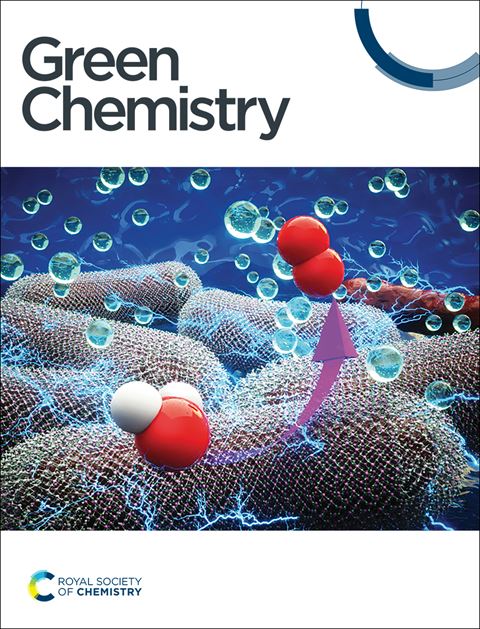桥塑料回收和清洁能源生产:无氢催化裂解聚乙烯在CuMgAlOx高产量柴油燃料生产†
IF 9.2
1区 化学
Q1 CHEMISTRY, MULTIDISCIPLINARY
引用次数: 0
摘要
塑料废物,特别是聚烯烃的年产量不断增加,强调了通过将这些废弃聚烯烃塑料转化为高价值产品来实现其价值的迫切需要。在此,我们报告了一种使用CuMgAlOx混合金属氧化物催化剂将高密度聚乙烯(HDPE)转化为柴油的催化热解技术,该技术具有快速的反应动力学,无需额外的溶剂、氢或贵金属。实验结果表明,在优化条件下,聚乙烯在500℃下几乎完全转化,停留时间为60 s,热解油收率达到85.7%,大大超过了目前的文献值。经色谱分析,热解油主要由烷烃(39.6%)、烯烃(42.4%)和烷烃(18.0%)组成。综合物理化学表征表明,该液体产品具有良好的柴油特性:低运动粘度(1.8 mm2 s−1),合适的密度(823.8 kg m−3),高热值(49.3 MJ kg−1),符合标准柴油规格。利用聚乙烯长链烷烃主链与十六烷的结构相似性,我们采用十六烷作为探针分子来阐明催化途径。该方法证实了CuMgAlOx催化剂促进氢转移和芳构化反应。通过自由基猝灭实验进行的机理研究确定了自由基介导的分解途径在催化热解过程中占主导地位。此外,开发的动力学模型准确地预测了产品在不同操作参数(450-600°C, 10-60 s停留时间)下的分布,与实验数据一致。本研究提出了一种高效的聚烯烃催化增值策略,在生产高价值运输燃料的同时,为解决塑料废物管理挑战提供了技术上可行的解决方案。该方法通过优化的多相催化系统将废弃聚乙烯直接转化为能量密集的碳氢化合物燃料,从而推进了塑料回收范例。本文章由计算机程序翻译,如有差异,请以英文原文为准。

Bridging plastic recycling and clean energy production: hydrogen-free catalytic pyrolysis of polyethylene over CuMgAlOx for high-yield diesel fuel generation†
The increasing annual production of plastic waste, particularly polyolefins, underscores the critical need to valorize these waste polyolefin plastics by converting them into high-value products. Herein, we report a catalytic pyrolysis technology for converting high-density polyethylene (HDPE) into diesel fuel using a CuMgAlOx mixed metal oxide catalyst, which exhibits rapid reaction kinetics without requiring additional solvents, hydrogen, or precious metals. Experimental results reveal nearly complete conversion of polyethylene under optimized conditions at 500 °C with 60 s residence time, achieving an exceptional pyrolysis oil yield of 85.7 wt% – significantly surpassing current literature values. The pyrolysis oil primarily comprises alkanes (39.6%), alkenes (42.4%), and alkylaromatics (18.0%) as determined by chromatographic analysis. Comprehensive physicochemical characterization shows that the liquid product exhibits favorable diesel fuel properties: low kinematic viscosity (1.8 mm2 s−1), appropriate density (823.8 kg m−3), and a high calorific value (49.3 MJ kg−1), all conforming to standard diesel specifications. Leveraging the structural similarity between polyethylene's long-chain alkane backbone and hexadecane, we employed the latter as a probe molecule to elucidate the catalytic pathway. This approach confirmed that the CuMgAlOx catalyst facilitates hydrogen transfer and aromatization reactions. Mechanistic investigations through radical quenching experiments established the dominance of a free radical-mediated decomposition pathway in the catalytic pyrolysis process. Furthermore, the developed kinetic model accurately predicts product distributions across operational parameters (450–600 °C, 10–60 s residence time), demonstrating robust agreement with experimental data. This study presents an efficient catalytic strategy for polyolefin valorization, offering a technically viable solution to address plastic waste management challenges while producing high-value transportation fuels. The methodology advances plastic recycling paradigms by enabling direct transformation of waste polyethylene into energy-dense hydrocarbon fuels through an optimized heterogeneous catalytic system.
求助全文
通过发布文献求助,成功后即可免费获取论文全文。
去求助
来源期刊

Green Chemistry
化学-化学综合
CiteScore
16.10
自引率
7.10%
发文量
677
审稿时长
1.4 months
期刊介绍:
Green Chemistry is a journal that provides a unique forum for the publication of innovative research on the development of alternative green and sustainable technologies. The scope of Green Chemistry is based on the definition proposed by Anastas and Warner (Green Chemistry: Theory and Practice, P T Anastas and J C Warner, Oxford University Press, Oxford, 1998), which defines green chemistry as the utilisation of a set of principles that reduces or eliminates the use or generation of hazardous substances in the design, manufacture and application of chemical products. Green Chemistry aims to reduce the environmental impact of the chemical enterprise by developing a technology base that is inherently non-toxic to living things and the environment. The journal welcomes submissions on all aspects of research relating to this endeavor and publishes original and significant cutting-edge research that is likely to be of wide general appeal. For a work to be published, it must present a significant advance in green chemistry, including a comparison with existing methods and a demonstration of advantages over those methods.
 求助内容:
求助内容: 应助结果提醒方式:
应助结果提醒方式:


